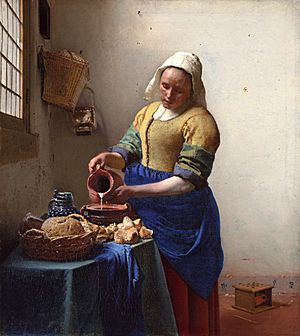The Milk Maid facts for kids
The Milk Maid is a famous oil painting created by the Dutch artist Johannes Vermeer around the year 1660. It's not a very big painting, measuring about 45.5 centimeters (17.9 inches) tall and 41 centimeters (16.1 inches) wide. Today, you can see this beautiful artwork at the Rijksmuseum in Amsterdam, Netherlands. It shows a simple scene from everyday life, which was common for paintings during Vermeer's time.
Contents
Discovering The Milkmaid Painting
This painting, often called The Milkmaid, is one of the most well-known works by Johannes Vermeer. It captures a quiet moment of a woman pouring milk. The painting is admired for its amazing detail, the way light is shown, and its calm feeling. It gives us a peek into what daily life might have been like in the 17th century.
Who Was Johannes Vermeer?
Johannes Vermeer was a Dutch painter who lived from 1632 to 1675. He is considered one of the greatest artists of the Dutch Golden Age. Even though he is very famous now, he was not widely known during his own time. He painted only about 35 to 36 paintings that we know of today. This small number makes his works very special and rare.
Vermeer lived and worked in the city of Delft, Netherlands. Most of his paintings show scenes inside homes, often with just one or two people. He was a master at using light to create a sense of depth and realism. His paintings often have a peaceful and thoughtful mood.
What's Happening in the Painting?
The Milk Maid shows a young woman, likely a housemaid, carefully pouring milk from a jug into a bowl. She is standing in a simple kitchen with a window on the left side. Light streams in through this window, lighting up her face, hands, and the objects on the table.
On the table, you can see a bread basket, some bread, and a blue cloth. The wall behind her is plain, but you can spot some nails and a small basket hanging there. The floor has tiles, and there's a foot warmer in the corner. Every item in the painting is shown with incredible detail, making it feel very real.
The Woman's Role
The woman in the painting is focused on her task. Her sleeves are rolled up, showing she is busy with work. She looks strong and calm. This painting celebrates the dignity of everyday work and ordinary people. It shows that even simple tasks can be beautiful and important.
Light and Color
Vermeer was a genius at painting light. In The Milk Maid, the light from the window makes the textures of the bread, the pottery, and the woman's clothes almost seem to glow. He used bright, clear colors, especially blues and yellows, which are common in his works. The way he painted the light makes the scene feel very alive and three-dimensional.
Why Is It Famous?
The Milk Maid is famous for several reasons. First, it shows Vermeer's incredible skill in painting light and texture. The way the light falls on the objects and the woman is truly masterful. Second, it captures a quiet, timeless moment of daily life. It's not a grand historical scene or a portrait of a rich person, but a simple, honest depiction of work.
The painting also stands out because of its realism. Viewers feel like they could step right into the kitchen. This attention to detail and the peaceful atmosphere make it one of Vermeer's most beloved works and a treasure of Dutch art. It reminds us that beauty can be found in the most ordinary moments.
Where Can You See It?
Today, The Milk Maid is one of the most popular attractions at the Rijksmuseum in Amsterdam. The Rijksmuseum is the national museum of the Netherlands and houses a vast collection of art and history. Seeing The Milk Maid in person allows visitors to appreciate its size, colors, and the amazing details that are sometimes hard to see in pictures. It remains a powerful example of Vermeer's unique artistic vision.


